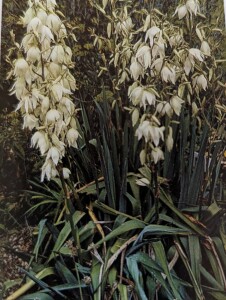It is rare that I see red about something green, but I am having an angry moment about yucca. Not all yucca, mind you—there are 40 or 50 species of yucca in the larger agave family—but Yucca filamentosa. I suppose that Yucca filamentosa, sometimes called “Adam’s Needle”, is loved in some places and tolerated in others, but I don’t want it in my garden.
I am sure you have seen the plants. Yucca filamentosa is a shrubby specimen that bursts forth from the earth in a rosette of long, sword-like leaves with slender “threads” or filaments curling from the edges. The rosettes can be up to two feet or more across on mature yuccas and each clump is about a foot high. In early summer flower stalks sprout, rising four or five feet above the plant. The white, bell-shaped flowers are clustered at the tops of the stalks, the better to attract the moths that pollinate them.
 Despite my dislike of yuccas, even I have to admit that the flowers are impressive and smell delicious. However, they fade, as flowers always do, and leave only the persistent, evergreen leaves. While the moths have been busy with the flowers above the ground, the plants have gone about the business of reproducing, which they do with enthusiasm. Underground tuberous roots spread readily, producing an unending supply of new plants, which is why it is hard to find just one yucca.
Despite my dislike of yuccas, even I have to admit that the flowers are impressive and smell delicious. However, they fade, as flowers always do, and leave only the persistent, evergreen leaves. While the moths have been busy with the flowers above the ground, the plants have gone about the business of reproducing, which they do with enthusiasm. Underground tuberous roots spread readily, producing an unending supply of new plants, which is why it is hard to find just one yucca.
Several years ago I went by an old cemetery that was engulfed in a sea of yucca plants, which happily cascaded down the hillside that bounded the property. Clearly someone—probably with the best of intentions—memorialized a loved one by planting a yucca at a gravesite. The plant then reproduced endlessly, thereby creating the yucca tsunami that I saw.
For years, I was afflicted with yucca in my front yard. Each year I would amputate the dead parts in the hopes of discouraging my yucca’s expansionist tendencies. It never worked. Finally, about 18 months ago, when the clump of yucca had grown offensively large, I decided to remove it. The process involved digging a hole about three feet wide and two feet deep and removing all of the tubers, which filled up an entire large lawn and leaf bag. The work was hot, tiring and seemingly unending, but I finally exorcized the yucca and its offspring. To celebrate, I planted a rose in the newly vacant space.
I have not missed the yucca for a single moment and reveled in the fact that it was gone for good.
I should not have reveled, because the yucca is back. I went out the other day in search of snowdrops and noticed that three young yuccas had sprouted up around the rose. I did not notice them last fall, but that is probably because the press of business took precedence over garden clean-up.
Clearly there were yucca tubers or tuber fragments that I overlooked on my search and destroy mission. Obeying the biological imperative, they recovered and started growing. Now they have gained enough strength to establish an above-ground foothold. This situation is intolerable.
I have not tested the soil around these invaders to see if I can get a garden fork into it, but I will do so this coming weekend. If there is any way that I can chisel out those yuccas now, I am going to do it. Waiting until spring may be necessary, but I hope not, because yuccas, like death and taxes, don’t wait. I refuse to sacrifice my new rose on an altar of yucca.
Some people probably love yucca for its sculptural quality, ease of culture and the fact that it will grow just about anywhere that isn’t swampy. With spreading root systems, the plants are also good erosion controllers. Yucca lovers are welcome to all the Yucca filamentosa that they can accommodate in their gardens. If I knew individuals of that ilk, I would send them the rogue plants now sprouting in my front yard.
If the ground is not frozen hard, I will have to check the supply of lawn and leaf bags, because yucca is like the iceberg that struck the Titanic—the visible parts are large, but the invisible parts are enormous enough to sink the unsuspecting gardener. I suspect that I will be amazed at the progress the tubers have made since my marathon yucca-removal effort 18 months ago.
Gardening is mostly a labor of love, but sometimes it has to be a labor of yucca.
